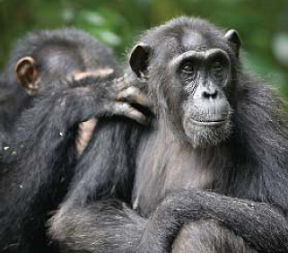Age Becomes Her: Male chimpanzees favor old females as mates
In the forests of Uganda’s Kibale National Park, male chimpanzees on the make know what they want in a sexual partner—wrinkled skin, ragged ears, irregular bald patches, broken teeth, and elongated nipples. For these guys, nothing beats the sex appeal of an old female chimp.

If that preference makes no sense to the average human male who’s entranced by young, smooth-skinned women, it’s because the mating game has evolved in different directions in chimps and in people, say anthropologist Martin N. Muller of Boston University and his colleagues.
People usually form long-term sexual partnerships. Men thus tend to look for women’s physical signs of youth, which signal childbearing potential for years to come, the researchers hold.
In contrast, adult chimps of both sexes mate with many partners. For male chimps, say the researchers, old females may be particularly alluring because of their demonstrated success at surviving and, in most cases, raising offspring.
If the new findings hold up, “a female’s proven ability to mother infants must be a very important factor for chimpanzee males seeking mates,” remarks anthropologist William C. McGrew of the University of Cambridge in England. McGrew has studied chimps at Tanzania’s Gombe National Park.
Muller and his coworkers observed the Ugandan chimp community of 12 males and 17 females from 1996 until 2003. The team tracked the chimps’ copulation and other sexual behavior. During most years, the researchers also recorded attacks, chases, and other aggressive behavior. They report their findings in the Nov. 21 Current Biology.
Male chimps mated substantially more often with females age 30 or older than they did with younger females, the researchers say. Even the oldest female, at roughly 55 years of age, attracted markedly more male interest than did young adult females, ages 15 to 20 years.
Moreover, compared with young females, over-30 females more often attracted groups of males during the females’ fertile periods, copulated more frequently with high-ranking males, and were more frequently the objects of fights between males for their sexual favors.
McGrew cautions that pinning down the exact age of wild chimps is difficult.
However, Muller notes that he and earlier researchers have tracked female Kibale chimps since 1983. The ages of females born before that year represent estimates, but age rankings are accurate, in his view.
A male mating preference for older females also characterizes Gombe chimps, comments behavioral ecologist Anne E. Pusey of the University of Minnesota in St. Paul, who directs ongoing research there. “Once Gombe females give birth to infants, they become more attractive to males,” Pusey says.
Researchers haven’t determined how long wild chimps can survive or whether wild female chimps can bear children throughout their lives, she adds.